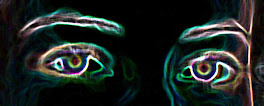
This image is taken from the title sequence of Stephen Spielberg's Catch Me If You Can. The sequence itself is a masterpiece, a small scale representation of the entire plot.
Sharp abstract shapes, geometric layout, and sleek design bespeak the modernized decades that encapsulate this intricate plot: 1940-60s. The style does not necessarily evoke a particular decade, but the mood it creates ushers the viewer into the commerce, advertising, and capitalism-soaked era of America.
The symbols employed throughout the sequence--including newspapers (as pictured above), stiletto heels, swimming pools, airplanes, and arrows--enhance the readability of the characters, settings, and scenes to come. They are small cues of the ideologies of accessibility, forward-progress, self-made men, and fatal romances--themes that lace themselves through the cat-and-mouse narrative.
Proportion. This concept is exploited to the fullest in this sequence, using size to depict important relationships that will be developed throughout the film. The above image is a good example. Tom Hanks plays the government character assigned to tract and contain Leonardo DiCaprio's character. In the title sequence, the "Tom Hanks man" looms above the slight, slender "Leonardo DiCaprio man" just as Agent Carl Hanratty lurks one step behind con-artist Frank Abagnale Jr. the entire film, breathing down his neck and looking over his shoulder.
Much more could be said of the brilliant title design of Catch Me If You Can; what did you think?
